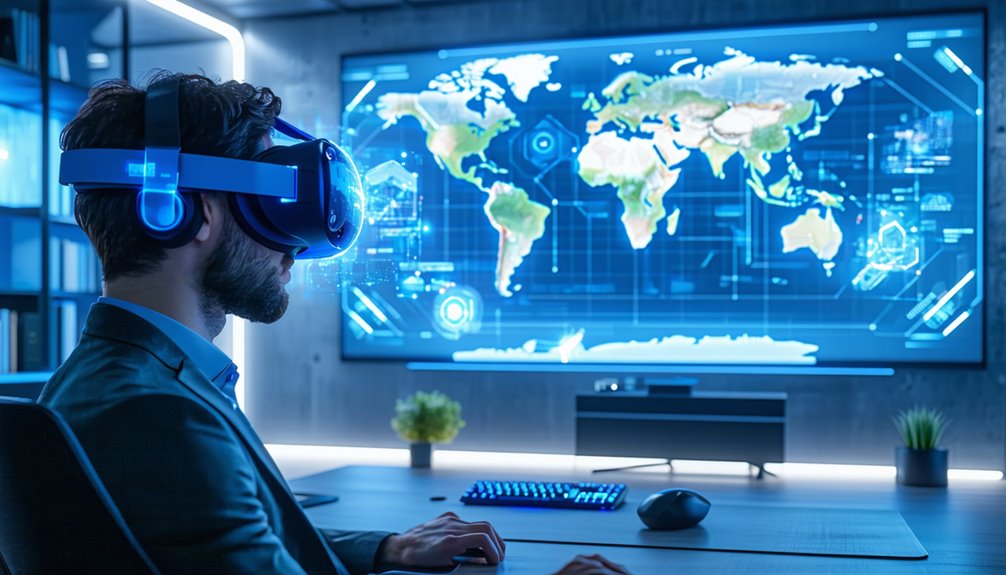As an agent in today's competitive environment, integrating Virtual Reality (VR) and Augmented Reality (AR) into your toolkit isn't just beneficial—it's key. These technologies can elevate client experiences and streamline processes, but successful implementation requires careful planning and execution. From selecting the right hardware to refining your development approach, understanding the nuances of VR and AR can greatly impact your effectiveness. What strategies will you adopt to stay ahead in this evolving field?
Key Technologies for VR and AR Implementation
As you explore the implementation of virtual and augmented reality (VR and AR), understanding the key technologies involved is critical for success.
Hardware integration plays a significant role, with headsets like the Oculus Rift and HTC Vive providing immersive experiences. Processors and cameras are necessary for AR, allowing effective rendering and capturing of real-world environments. Sensors track user movements, enhancing interaction, while gloves and suits offer haptic feedback for realism in advanced VR systems. Mixed Reality (MR) applications, which combine elements of AR and VR, further expand the potential for user engagement and interaction.
On the software side, optimization through 3D modeling software and image registration is important for accurate content overlay. Content management systems and ARML streamline the organization of virtual objects.
Gaze and gesture recognition guarantees seamless user interaction, making these technologies fundamental to successful VR and AR projects.
Development Process for Effective VR and AR Projects
Understanding the key technologies for VR and AR implementation sets the stage for a structured development process that guarantees project success. Begin with thorough project planning, encompassing pre-development activities like research and concept development. Selecting the right development platform—be it Unity or ARKit—is important. As you move into coding, focus on creating intuitive user interfaces and engaging 3D models. To enhance user accessibility, consider the impact of housing affordability challenges that may affect your target audience's ability to engage with technology. Iterative development allows for incorporating user feedback at various stages, ensuring the product aligns with user expectations. This internal research cost typically borne by the client is crucial for developing a comprehensive understanding of the project's requirements. Post-development, emphasize usability testing and performance optimization to refine the application. Finally, establish clear channels for deployment and ongoing maintenance, planning for future updates that respond to user feedback. This structured approach fosters effective VR and AR project outcomes.
Challenges and Opportunities in the VR and AR Landscape
While the potential for virtual and augmented reality is vast, traversing the environment presents both notable challenges and exciting opportunities. You should consider these key factors:
- Hardware Limitations: Lightweight, affordable devices are important for user adoption.
- Software Development: Creating engaging content requires sophisticated programming and cross-platform compatibility. Cross-platform compatibility is essential for reaching a wider audience and ensuring a seamless experience across different devices.
- Cost Barriers: High initial costs impede widespread adoption and integration.
- User Experience: Enhancements in user experience can drive market growth, especially in healthcare applications.
Navigating these challenges can lead to breakthroughs in education, marketing, and remote collaboration, ultimately transforming how you engage with technology.
Frequently Asked Questions
What ARe the Hardware Requirements for Optimal VR and AR Experiences?
To optimize your VR and AR experiences, ensure your hardware meets specifications like those for Oculus Rift or HTC Vive, focusing on graphics quality, performance optimization, and sufficient RAM for an important user experience.
How Can I Ensure Cross-Platform Compatibility for My VR or AR App?
To guarantee cross-platform compatibility for your app, leverage cross-platform frameworks that accommodate device diversity. Regularly test across different platforms, optimize for varied hardware capabilities, and prioritize consistent user experiences to enhance functionality and satisfaction.
What ARe the Best Practices for User Testing in VR and AR Projects?
To enhance immersive experiences, prioritize usability testing and gather user feedback. Implement iterative design processes, ensuring adjustments based on insights. This approach fosters better engagement and satisfaction, ultimately leading to more effective VR and AR solutions.
How Do I Address Privacy Concerns in My AR or VR Application?
To address privacy concerns in your application, prioritize data protection and guarantee user consent. Clearly communicate data practices, provide customizable privacy settings, and regularly audit your security measures to maintain trust and transparency with users.
What Resources ARe Available for Learning VR and AR Development?
You've got plenty of resources for learning VR and AR development. Explore online courses for structured knowledge and join development communities to gain insights and feedback. Networking with peers enhances your learning experience significantly.
References
- https://mobidev.biz/blog/augmented-reality-development-guide
- https://research.cbs.dk/files/58424530/federica_cehovin_og_bernice_ruban.pdf
- https://www.scnsoft.com/virtual-reality
- https://www.itu.int/en/ITU-T/focusgroups/mv/Documents/List of FG-MV deliverables/FGMV-07.pdf
- https://curioxr.com/virtual-reality-implementation-guide-vrig/
- https://www.tdk.com/en/tech-mag/past-present-future-tech/ar-vr-mr
- https://ismguide.com/new-virtual-reality-and-augmented-reality-strategy-implementation-practice/
- https://www.splunk.com/en_us/blog/learn/ar-vr.html
- https://dspace.mit.edu/handle/1721.1/124035
- https://dreamfarmagency.com/blog/basics-of-ar-vr/

